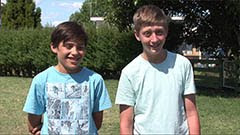Every film or television programme is made up of multiple shots and angles that are put together in sequence to create the story line. When talking or reviewing a shot, the length, angle and movement of each need to be considered. We needed to look at these before filming our thriller, learning which ones would be best to use and when. After researching these i
decided to take some examples using my camera.
The most common shot/angle types include:
Extreme long shot: also known as an establishing shot.

This is most often used to set the scene indicating where the particular film or television programme is taking place. They may often be shots of famous land marks to show where the action is taking place such as Big Ben to identify London for example. This shot can also be used to convey big action scenes, allowing you to see all of what is going on, when representing a war is an example. There is usually very little detail visible in this shot, as it is normally intended to give general rather than specific information.
Long shot: also known as a wide shot


This is a shot in which you are close enough to see a particular character or object whilst still placing the emphasis on the environment - usually aiming to create a link between the two. This typically shows the entire object or human figure and the surroundings around them. The second example here could be said to be a long-medium shot - being in between the two.
Medium shot:
This shows the particular subject in some detail, whilst still allowing some of the setting to be seen. For example if it were a person we were being shown, they would usually be able to be seen down to their waist, leaving the legs off which could be seen to be unnecessary anyway. This is appropriate when the subject is speaking without much emotion or concentration. This shot also allows movement such as hang gestures to be seen and is a natural looking shot. The second example is of a medium two shot - referring to a shot with two people in the frame.
Medium-close up:
This is a shot in between a medium shot and a close up, allowing you to see the subject in more detail without you getting uncomfortably close.
Close up:
This is when a certain feature or object takes up most of the frame. They are particularly useful in showing detail and causing the audience to focus on a specific things, often used with cut-ins. (specifically showing a certain part of the subject) They are usually used to emphasize a persons state of mind, exaggerating facial expressions to convey emotion, almost taking you 'inside the mind' of a character.
Extreme close up:
This gets very close to show
extreme detail. It is to close to show emotion unless it is a very dramatic scene and you would usually need a specific reason to use one of these. However, they can be beneficial when you really want your audience to see something - this shot could also be used in horror and thriller films, as they can sometimes cause
confusion being so close effectively. An eye opening is often an example of an extreme close up or even a tear running down a cheek.
Two shot:
This is a shot of two people, a natural way of introducing them and is good for establishing a relationship between the two. They will usually have an equal stance and distance in the frame, implicating equality however this is not always the case. They can also be used to show that one person is domineering over the other by the stand they are positioned in, with perhaps one standing up and one sitting down for example.
Over the shoulder shot:

This places you behind a subject who is looking at another one in front. We are shown the back of a person, typically placed in the frame about 1/3 of the way and the other will be almost facing the camera due to looking at the subject we are placed behind, taking up the rest of the frame however this can vary slightly. This helps give you the feel as though you are looking at the person by the others point of view and helps establish the position of each person.
Point of view shot:

This shows a view from the subjects perspective, showing what the character is looking at. Sometimes this is taken over the shoulder of the person with them remaining in the frame.
Ariel shot:

This type of shot is usually taken from a plane, crane, balloon etc often used to show dramatic pans and are beneficial when wanting to view large landscapes. For example, when shooting a scene above the top of a building this could be used to show just how high up they are and there proportion to the rest of the surroundings. The example used is an image taken when we were looking into the location of our thriller.












No comments:
Post a Comment